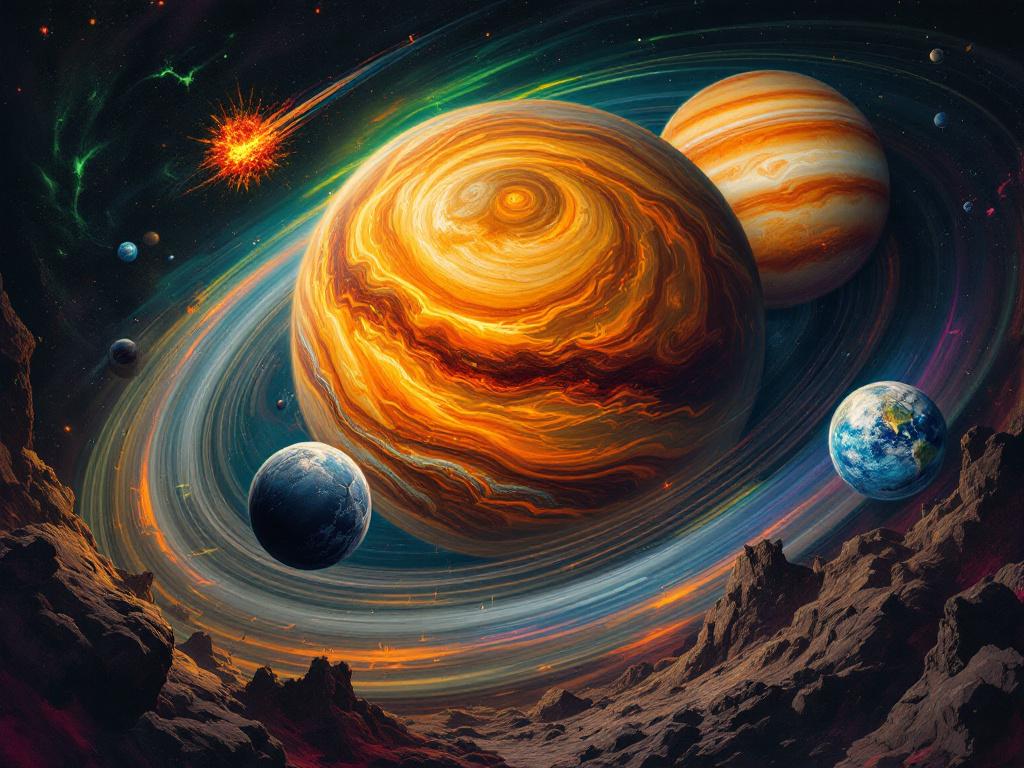The Cursed Moons of Jupiter: A Miniature Solar System of Nightmares
When we look at Jupiter in the night sky, it seems like a simple bright dot. But behind that glow hides a colossus, a failed star that could have changed the fate of Earth. Around it orbit dozens of moons, alien and spectral worlds that form a miniature solar system, made of fire volcanoes, hidden oceans, and deserts of ancient ice. A toxic and lethal kingdom that feels alive in its own disturbing way.
🌌 Jupiter, the Star That Never Was
With a mass 318 times that of Earth, Jupiter was on the verge of being a star. It only lacked the mass required to ignite nuclear fusion in its core. If it had succeeded, today we would live in a binary system: two suns in the sky.
But Earth would not be the same: the delicate balance of orbits would have collapsed, planets would have gone astray, and our world would likely have been cast into interstellar cold or burned under a double sun.
🌋 Io, the Inferno of Sulfur and Fire
Io is the closest of the great Jovian moons, and its name could not be more fitting. It is a hellish planet, covered by volcanoes that spew lava and sulfur hundreds of kilometers high. Its landscape resembles Dante’s nightmare: rivers of fire, toxic lakes, smoking mountains. No place in the Solar System is as geologically alive… and as hostile.
❄️ Europa, the Ocean Buried Beneath Ice
At first glance, Europa looks like a frozen ball. But beneath its surface, kilometers thick, hides a liquid ocean, larger than all Earth’s oceans combined. An ocean wrapped in eternal darkness, perhaps populated by abyssal alien life forms.
But Europa is no refuge: its surface is swept by deadly radiation from Jupiter. Just a few hours on its icy crust would be enough to kill any astronaut.
🧊 Ganymede and Callisto, the Silent Giants
Ganymede, the largest moon in the Solar System, is so huge it even possesses its own magnetic field — a unique fact among satellites. A failed planet that seems to guard secrets within its frozen depths.
Callisto, on the other hand, looks like a cosmic graveyard: its surface is scarred by billions of craters, mute memories of ancient collisions. Dead worlds, yet disturbingly eternal in their silence.
☢️ The Toxic Aura of Jupiter
If Jupiter had a “breath,” it would be poison. The gas giant is surrounded by radiation belts so intense they can fry a probe’s electronics in hours and annihilate an unprotected human body. It’s as if Jupiter guards its secrets behind an invisible and lethal wall. A true toxic shield that makes the Jovian system one of the most dangerous places in the cosmos.
🌠 What If Jupiter Had Become a Star…
Jupiter is often called a failed star: had it been about 80 times more massive, it would have ignited nuclear fusion, becoming a small brown dwarf or even a second sun. But what if our Solar System had been binary?
Earth would never be the same. The fragile orbit that today allows life to thrive would be shattered by a new gravitational balance. Disturbing scenarios emerge:
- 🌍 Earth expelled into darkness: a second sun would have destabilized our orbit, hurling us into the frozen void of interstellar space — a dead, wandering relic.
- 🔥 Earth incinerated: or worse, placed too close to double radiation. Oceans would evaporate, the atmosphere carbonized, and life would never have emerged.
- 🪐 A chaotic solar system: the orbits of Venus, Mars, and other planets would have gone mad. Some worlds would fall into the Sun, others ejected into eternal night.
In short, if Jupiter had turned into a star, the universe would never have given us the Earth as we know it. Our very existence depends on the fact that Jupiter failed its stellar ascension.
But there’s more: its moons — Io, Europa, Ganymede, and Callisto — would not have been satellites, but miniature planets orbiting a newborn star, worlds warmed by two suns, perhaps even with liquid oceans on their surfaces. In a way, they might have become the true heirs of life, not us.
A chilling thought: had Jupiter ignited, Earth would never have existed as we know it… and the only intelligent creatures in the universe might have lived on the cursed moons of Jupiter.
Conclusion
The moons of Jupiter are not just distant worlds: they are cosmic warnings. They remind us that space is not silent, but filled with real monsters: sulfur volcanoes, radioactive oceans, eternal ice deserts.
Jupiter, with its toxic and titanic reign, is proof that our Solar System is not a serene refuge, but a theater of natural horrors constantly reminding us how fragile we are.








Leave a Comment